|
FAQs about Acroporid Coral Disease/Health,
Parasites, Pests 8
FAQs on Acroporid Disease:
Acroporid Disease 1, Acroporid Disease 2, Acroporid Disease 3, Acroporid Disease/Pests/Predators
4, Acroporid Health
5, Acroporid Health
6, Acroporid Health
7, Acroporid
Hlth. 9, Acroporid Hlth. 10,
FAQs on Acroporid Disease by Category:
Diagnosing,
Environmental (Pollution/Poisoning, Lighting...),
Nutritional, Social (Allelopathy),
Trauma,
Pathogenic (Infectious, Parasitic, Viral)
Predatory/Pest
(see below), Treatments
FAQs on Pests of Acroporids:
Montipora Munching Nudibranchs,
Flatworms,
Red/Black "Bugs"
Acropora Munching Copepods,
Related Articles: Coral Pests and Disease; pests, predators,
diseases and conditions by Sara Mavinkurve, Acroporids, SPS
Corals,
FAQs on Stony Coral Disease by Type: Brown Jelly Disease, RTN,
|
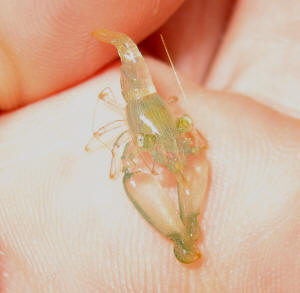
|
|
White spots on Montipora capricornis: RTN\Brown Jelly
Disease. 4/9/2010
Hello!
<Hi Tom.>
I have attached an image of my orange Montipora capricornis.
<I had one similar, as well as a purple rimmed
variety.>
It has been doing wonderfully since I got it a few months ago,
and has grown to about 6 times the original size.
<Mine were growing well also.>
In the past 2 or 3 days, it has begun to develop white spots on
it that are spreading fairly rapidly and now appearing in other
locations on its top surface.
<Same thing that happened to mine. It isn't bleaching,
that is tissue death\Brown Jelly Disease.>
I have inspected for Nudibranchs but have found none.
<Not Nudibranchs.>
This is the only coral in the tank that appears to be having any
kind of problem.
<All of my LPS and Softies were not affected.>
All other SPS, LPS and soft corals are doing very well. Even two
Goniopora have been rapidly growing for over 3 years. (Funny... I
refused to buy them at the LFS, but a co-worker persisted so I
reluctantly agreed as long as they paid for them. Its now years
later and they are at least 10 times the size and have encrusted
onto multiple other rocks. No idea why, but I have had great luck
with these, but back to the matter at hand...)
<Congratulations, Goniopora are not easily kept.>
The tank is 135g with 40g refugium/sump.
Fish load is light. 3 damsels, 1 Blue tang (4"), 1 Scopas
tang (3"), 1 Banded Cardinalfish,
1 Watchman goby, 1 Blue-spotted blenny, 1 Ocellaris clownfish, 1
Six-line wrasse.
<No culprit there>
I do 25% water changes monthly like its a religion (last change
was exactly two weeks ago), and I run 3 bags of charcoal in
direct flow in my refugium to combat allelopathy, changing one at
a time. Skimmer is an AquaC EV120 that skims about a gallon of
skimmate a week. Also running is a phosphate reactor. I grow and
harvest Chaeto in the refugium.
<All sounds good there as well.>
In short, everything is going wonderfully beyond my wildest
dreams. And now this problem just popped up in this one
coral.
<This took out a large number of Montis in my local reef
club>
Do you think that it is a Nudibranch infestation that I'm not
seeing?
<No.>
The only other thing I can think of is that its close to time to
change my bulbs.
I run two 250w MH lights and change the bulbs every year.
Its been a year and a week. Would such a rapid development of
these white spots seem like it would be caused by
old bulbs?
<No, Old bulbs or the wrong light would show bleaching all
over, not in spots. and you would see a reaction in your other
corals as well.>
Please let me know if you would like any more info from me.
<Water parameters are always helpful. However, if everything
else is going well, I'm sure yours would not reveal any
'smoking guns'. >
<Do read here: http://www.wetwebmedia.com/corldisart.html
and do a Google search on the site for Brown Jelly Disease. This
'disease' kills and it kills quickly. It seems to start
by a small, insignificant injury and spreads rapidly from there.
As it spreads, you will start to see a brown or tan goo floating
above the coral. I was able to save a piece of each of my colony
by fragging a healthy part of the coral furthest away from the
infection and keeping it in another tank. You can try sucking up
the goo with a turkey baster and getting it out of your system.
Unfortunately, it did not work for me. I also tried applying a
dilute Lugol's solution directly on the coral using a
pipette. About the only thing I did not try, as it was
impractical, was removing he rock the coral was attached to a
hospital tank and treating with antibiotics, though that could
kill the coral just as quickly as the disease can.>
I appreciate the work you guys do there immensely, and I can
certainly say that the point when I found wetwebmedia.com was the
turning point in the hobby for me.
Thank you for being you.
<Thank you for the kind words and the best of luck in treating
this.>
-Tom
<MikeV>
|
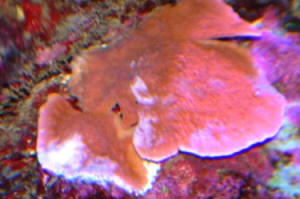 |
|
Acro Crab? Possible Trapeziid or Juvenile of
Undetermined Family -- 3/28/10
<Hi Mike, Lynn here today.>
Just found this little crab on a new shipment I just
received.
<Neat! What kind of shipment -- coral (Acropora, Pocillopora,
Stylophora, etc.?), rock, or something else? Where was the
shipment from? What's the size of the crab (carapace
width)?>
Hoping you can confirm whether of not it's an Acro crab?
<That's a tall order! Did it hitchhike in on an Acropora
colony? It could be a coral crab, or it could simply be a
juvenile of some other variety. It has the same large eyes,
roughly triangular carapace, and claw length/shape that you see
in many Trapeziid crabs (family Trapeziidae -- aka 'coral
crabs' or 'coral guard crabs'), but the color/pattern
of the carapace is atypical. That is, it doesn't fit with
what photos I've seen of Trapeziid crabs. The problem is that
there are an awful lot of crab species out there, not all of
which are available as photos on the web or in my research books.
What you have may be a coral crab that in its juvenile phase has
a completely different, more cryptic coloration, than its adult
counterpart. This is not at all unusual in crabs, or other
animals for that matter. Unfortunately, I haven't been able
to find any photos of juvenile Trapeziid crabs for comparison.
Again, there's the distinct possibility that this little crab
could simply be a juvenile from any number of other families.
Juvenile crabs typically have the same large eyes that you see in
Trapeziids. The bottom line here is that unfortunately, all I can
offer are a whole lot of maybes and no concrete answers. Time and
behavior will tell with this little fellow. I can tell you one
thing though. Trapeziids are generally found in the Pacific,
either the Indo-West or tropical Eastern regions. If this little
crab came in on a shipment from say Florida or the Caribbean,
chances are it's not a Trapeziid. Please see the following
link for an example of a juvenile Callinectes sapidus, aka
'blue crab' (see last photo). This is definitely not what
you have (and not a variety of coral crab), but you can see the
similarities:
http://www.serc.si.edu/education/resources/bluecrab/lifecycle.aspx
Here are some examples of coral crabs, along with more info (see
bottom of page):
http://www.chucksaddiction.com/hitchcrabs.html
More info at WWM:
http://www.wetwebmedia.com/Arthropoda/CrustaceanPIX/SWCrabs/Crab%20IDs/SWCrabs3.htm
>
And good/bad?
<Time will tell. This could be a relatively harmless coral
crab, or something else entirely. Since I can't confirm
either way, I'll offer the standard crab warning. That is,
crabs are omnivorous opportunists and scavengers that, if hungry
enough, can and will eat pretty much anything they can grab with
their claws. You have the choice of keeping, observing, and
removing if/when the crab becomes a problem or playing it safe
and putting it elsewhere until you have a better idea what it is
and how much risk it poses to other livestock. Either way, do be
sure to keep it well-fed with meaty scraps of marine origin
(shrimp, clam, squid, fish, etc.) or perhaps sinking
pellets.>
Attached a pic for ID.
<Thanks, he/she certainly appears to be an itty-bitty
thing!>
Thanks!!
<You're welcome!>
Mike
<Take care, LynnZ>
Re: Acro Crab? Possible Trapeziid or Juvenile of
Undetermined Family -- 3/28/10
Lynn,
<Hi Mike>
Thank you for the response.
<You're very welcome.>
He was attached to a "purple monster Acro" from either
the Solomon Islands or Fiji, my supplier only specified vaguely
where all our corals came from, one or the other.
<Thanks, that helps. I just wish that it was enough to be able
to offer you a positive ID! As it stands right now, I'm not
sure what type of crab this is. As was evident in the photo of
the blue crab (see link in previous response), appearance can
change significantly from juvenile to adult. We should know more
as this little fellow matures. Honestly, it could be one of many
different genera (not just in the family Trapeziidae) that are
associated with Acroporids. It could also be an accidental
hitchhiker; that is, not a coral crab at all. Perhaps it was
ousted from its normal habitat during collection and simply took
refuge within the coral's branches.>
I've attached a not so macro pic for a naked eye view as
well. He is tiny, maybe 3-4 mm.
<Yep, that is one small crab!>
Thanks again!
<It was a pleasure! I'm just sorry that I couldn't
give you a more definitive answer.>
Mike
<Take care, LynnZ>
|
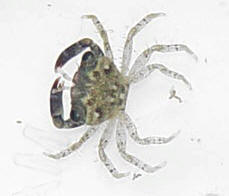 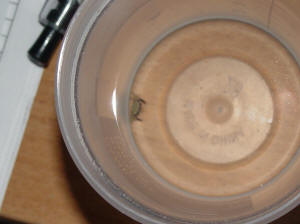 |
|
Acro Damage - Need a second set of eyes
1/5/10
Good Morning,
<... what is it about asking people to limit their attached
file size that isn't clear? Perhaps the request isn't
sufficiently prominent?>
________________________________
Noticed this unfortunate damage last night when I got home from
work...
I have had this piece for over a year, since it was a little frag
about 1/2". My first thought when I saw the discoloration
and splotchiness, was OH NO AEFW!
<Don't think so>
After calming down and taking closer examination, I realized two
things, this damage occurred in less than a 24hr period, the
piece was perfect on Sunday when I did tank maintenance, and
second I always dip all new arrivals religiously and observe with
a magnifying glass.
<Good technique>
I think it would be extremely aggressive for a pest to do this
much damage in a single day, but stranger things have happened. I
also remembered I changed my lighting schedule on Sunday and
increased the MH by 1.5 hours (accidental, intended to only
increase 30 minutes!)... This piece was high up on my rock and
just off the axis of one of my XM10K bulbs.
<Mmmm>
Sorry the pictures aren't better, I removed it, dipped it in
TMPCC
<Won't help>
and put it in my frag tank before taking this picture, hence the
sliming. I observed in a white bowl after dipping for 10mins, and
didn't find anything, but it's easy to miss things.
Looking for more opinions. The light colored discoloration, seems
to overlap in alot
<... no such word>
of places and be much larger than bite marks that I have seen
from FW's.
What does everyone think? Lighting Cycle Damage/Bleaching or
Pests?
Thanks so Much,
Landen
<Something direly amiss; and not the last. Am almost tempted
to ask you to CAREFULLY turn off your MHs, take the lamps out and
examine them for a crack... Bob Fenner>
Re: Acro Damage - Need a second set of eyes
1/5/10
A little further information for consideration...
<Okay>
Went home at lunch and did further examination. No signs of eggs,
FW's, or anything else. I took the coral out of the frag tank
and examined it under direct sunlight with a magnifying glass,
and I flushed it with a turkey baster again.. Nothing showed
up!
I did discover that my Alk is very low at 6.5-7 for some reason,
and I am wondering if the reason for the discoloration is stress
related from the Alk combined with the lighting change.
<Might somehow be related events... the bleaching "eating
up" the Alk.
BobF, soon B>
|
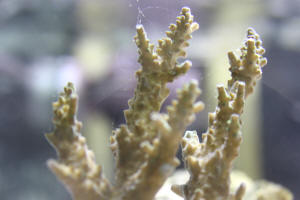 |
Re: Acro Damage - Need a second set
of eyes 1/6/10
Bob,
<Landen>
Thanks so much for the reply! Sorry about the size of the
attachments, meant to send the scaled down "internet
versions" and ended up attaching the full resolution...
<Ahh! Though our mail-server of the last few years has bigger
"storage", we do come close some days to overwhelming
it... and having incoming mail bounced... Hence the concern>
I followed your advice and checked the bulb directly above it, and
the one to the side of it. Unfortunately didn't find anything
that I can see with the naked eye, also there were no signs of
condensation in the bulb. Will keep a close eye on it.
<Please do>
I agree, something is amiss, I have since moved it to my frag tank
for further examination.
<Good move>
All water parameters are spot on with the exception of Alk, I
don't know if there is anything else I can do other than keep a
very close eye on things and wait. If this isn't pest related,
at least I can breathe a little easier.
<There are a "myriad" (large, diverse, even unknown)
of "chemical, physical and biological" factors for which
there are no tests, little known, that can/do affect aquatic
life...>
Also, I think I remember this site had a Donate button just below
the "Admin Index" and "Cover Images" links,
does this still exist?
<Oh yes>
Will look further, maybe I overlooked it somewhere. This team is a
phenomenal source of information, and deserves all the support and
funds it can get.
Landen
<Thank you for your kind words. Happily, no one on the Crew
works for money here (there is little to go about); the funds being
spent about half on our on-line magazine (for adding content),
helping/subsidizing folks to get dive-certified, dive-travel,
attend hobby, business and some scientific conferences. Cheers!
BobF> |
|
Need your help with new Montipora
12/23/09
Folks, I am hopeful, but scared.
<Mmm...>
I bought a small Montipora frag online - the coral came on time,
about 16 hours after being mailed, packed very well in Styrofoam
box, with heater pack, etc. It looked great in the bag (see
picture Monti 1).
<Okay>
I acclimated it the best way I know how - floated the bag in the
tank and poured tank water into the bag at regular intervals over
approximately 45 minutes.
<Umm, wait... Did you measure the pH of the shipping/bag water
and adjust the acclimation water to it/this? Mistake
otherwise>
The tank water I put in the bag was dosed with Coral dip at the
usual dosage. The coral seemed to tolerate the acclimation in the
bag just fine.
What I did not do is check the pH or salinity of the water in the
bag before putting my tank water in.
<A problem>
At the end of the 30-45 minute acclimation process I took the
coral out of the bag and placed it gently at the bottom of the
tank. It bleached immediately, and has not a bit of color since
(see photo Monti 2).
<Is dead>
Is it dead? What could I have done differently? Is there any way
to save it? Its' been almost 24 hours since I put it into the
tank and it remains completely white.
Here is my setup: 6 gallon Nano tank - 11 inches deep with 36
watts of 50/50 PC bulbs.
Water parameters at the time I put the coral in yesterday:
Salinity: 35 ppt
pH 8.2
Ammonia 0
Nitrite 0
Nitrate 0
Alkalinity 3 mEq/L
Calcium 460
Magnesium 1395
Phosphate 0
As you can see, I put the Montipora at the very bottom of the
tank, thinking I would move it up to the very top rock (which is
about 3-4 inches away from the lights) over a couple of days.
Should I move it to the top now? Again, it bleached immediately
after being put in the tank (seconds).
All of my other corals are OK, including the Birdsnest you see in
the top right corner. The tank has been up and running for 2
months and has been very stable. The other inhabitants are:
A few snails and a red-legged hermit as CUC
Acan lord (1) head
Candy cane (1 head)
(Moseleya (1 head)
Birdsnest (3 inch piece)
One 1.5 inch purple Dottyback
All the other tank inhabitants have been in there for one week or
longer (tank stocked in stages).
Please help - I really like the little Monti... BTW, I am new to
the hobby, in case you can't tell.
<Small volumes/systems are hard to keep viable... Please read
here re acclimating:
http://wetwebmedia.com/acclimat.htm
in particular, the second piece on "Guerilla
Acclimation" (or acclimating for the business, and organisms
that have been "bagged" for long durations.
Bob Fenner>
|
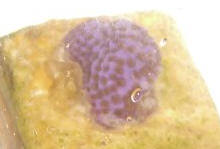 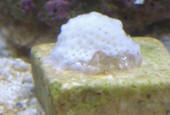  |
|
Re: Need your help with new Montipora
12/23/2009
Thanks for the response and the link, Mr. Fenner. Lesson(s)
learned about correct acclimating.
<Ah good>
The coral certainly appears dead, doesn't it. I did not see
any flesh floating away, but it is a very small frag. I am hoping
against hope, so I will leave it in the tank for a month or
so.
<Good idea... no harm otherwise at this point, and one never
knows... if even just a bit of tissue is alive, it might well
regenerate>
In case there are any live cells left in the rock that may decide
to replicate, would it be better to move the piece close to the
lights now, or will that just introduce more stress (to the
otherwise dead) animal?
<No worries. BobF>
|
AEFW Problem... they said our flatworms were no fun --
11/27/09
Hello,
I discovered my 1" Lokani frag had been decimated by a few
AEFW.
<Acroporid eaters>
I was trying to figure out why it was losing so much color, checked
water param.s, Alk/cal. lighting scheme, all was fine...had no idea
what was going on. Didn't suspect AEFW at first because I
didn't see anything. After a second closer look a couple weeks
later, light brown patches, used a pair of tweezers to see if they
would move, they sure did and confirmed that they are indeed aefw. Read
up on it, not any known cures....
<Mmm, actually>
was wondering if you know if Salifert's Flatworm eXIT stuff
works?
<I do and it does>
I have some on hand, I bet it works for regular Planaria, will it kill
AEFW too?
<Yep>
I added a Sixline wrasse I had in a holding tank in hopes of at least
putting a predator in there, doubt he will really solve or even reduce
the problem. The flatworms have not overwhelmed tank yet, but my one
Lokani
frag is a goner, and starting to see a couple of my solitariness
pieces lose color at the bases, tell tale signs they are laying eggs
there and starting to create a stronghold in the tank.
<Bunk!>
so let me know if there are ways to treat the whole tank. I would hate
to clip out and quarantine every Acro to see one flatworm creep out
from the liverock and reinfest all the quarantined pieces again.
Let me know,
Thanks,
Matthew
<There are Anthelminthics... Levamisol is a fave... Prazi/quantel...
just got to make sure that the chemical aftermath of kill off
doesn't take all else with it... Lots of new water pre-made to
switch out, chemical
filtrants (GAC, PolyFilter...) to add. Bob Fenner>
Live Rock - Montipora Digitata 9/16/09
Hi crew,
<Henk>
I am just starting up my first marine system, and the live rock has
been placed in the system about two weeks. Since the tank is cycling
with normal lighting cycle I am experiencing quite some algae growth.
Mainly some fine Green Hair Algae but also some Bryopsis. The live rock
was collected from the coast in south China and shipped by air directly
to me (in Beijing). I washed the live rock before placing it in the
tank, but did not brush aggressively, merely shake and blow of detritus
with a powerhead. Two large
pieces of live rock are apparently dead pieces of Montipora Digitata,
with three or four tips of about 0.5 to 1 inch of live coral, colored
blue-brown and with polyp extension. My question is: do I need to do
anything if I would like to keep this coral alive, or will the fact
that it is connected to the dead coral (partly overgrown with algae
currently) not affect its chances or survival?
<Possibly either way...>
The tank is still cycling. This is a system of 150 gallon with two
metal halides of 250W as lighting. During the cycling, I am doing water
changes weekly of about 10%. The skimmer is a Bubble Magus 200E2 (local
Chinese brand, rated for systems up to 390 gallon) with Eheim Pump 1264
and circulation is provided with an Atman return pump of 5000L/H and 2
Tunze 6105 pumps on a multicontroller. I have not tested the water yet
since I suppose the tank is still cycling, but will do so soon.
<I would... Likely you could use some chemical filtration, and
possibly larger water change outs, some supplementation for biominerals
and alkalinity for sure>
Any advise would be appreciated. I have been reading for a long time on
your site before setting up this tank, and have found it to be of great
help, and my first and major reference for any question regarding
marine or freshwater systems.
Regards,
Henk Naert
<Do search on WWM for the terms mentioned for more background,
direction.
Bob Fenner>
|
Reef Tank: Need an ID weird tube structure
8/29/2009
Hey guys I keep getting this tube like formation around my
Montiporas.
It has a consistency of super glue, mixed with sand. I tear it
apart in hopes of catching something inside but to no avail. Any
chance you guys know what it is and how to catch it?
<I suspect this is a type of tumour caused by pathogenic
bacteria...>
It's annoying, it eats/erodes the side of the Montipora it
attaches to build its tube structure.
Also the structure is built on the live rock. I attached some
photos to see if you can ID it.
Thanks,
Mark
<Please read here:
http://www.coremoc.go.jp/english/pub/coralreefjapan/0203_coral_diseases.pdf
Bob Fenner>
|
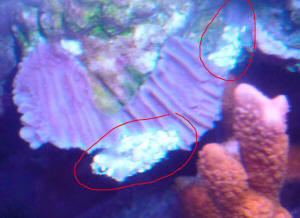 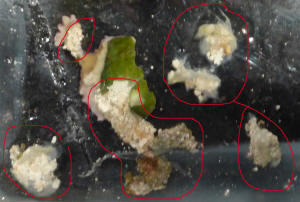 |
|
Struggling with SPS 7/21/2009
I am a long time SPS keeper and have a great deal of success over
the years
- until now. I setup a 1000L tank approximately 9 months ago
(from the stock
in my 4x2x2) and have seen a progressive slide in the health of
my corals over recent months. I have provided my tank details at
the bottom of the message and also attached a photo showing one
of my corals. It is hard to describe but the corals are showing
signs of mucus production, minor recession of the tissue, a
mould/fungus like covering. This appears to be affecting older
parts of the colonies more than new growth. None of my LPS are
showing any signs of stress in fact a recent bit of damage to an
elegance healed up nicely in two weeks without an issue.
<Perhaps a clue>
I am at a loss. I thought I had a fairly well setup tank but I am
now considering pulling it down as I cant get on top of the
issue. Thank you for any help you can provide.
http://i88.photobucket.com/albums/k179/kirsto71/New%20Tank/P5100027.jpg
System Type: Mixed Reef
Display System:
Strike up Date: Oct 2008
Display Tank: 6 x 3 x 26inch. Cross braced and euro braced
Display Lighting: 3 x 250w MH. IceCap Electronic ballasts and
Lumen Bright reflectors 20k bulbs
Stand: 50x50 Galv Steel
Hood: 50x50 RHS
Sump: 110x60x45 cm Sump
Refugium: Compartmentalized in sump
Refugium Lighting: 2 x Double HO-T5's 10k bulbs
Support systems:
System Water: NSW
<Another set of possibilities>
Display Water circulation: 2 x Iwaki MD70's driving eductors
in closed loop format, 1 x 15000 LPH closed loop pump through
base of tank, Tunze Wavebox, 2 x 6000 LPH Koralia copies plus
waiting to order a Vortech Return Pump: Laguna 11000 LPH
Skimmer: Turbo 1200mm Tall Recirculating Beckett Skimmer driven
by a 7200
LPH pump
Evaporation Top Up: Iwaki dosing pump controlled by
Aquatronica
System Control: Aquatronica. Controls:
Auto water change (15 L per day)
Metal halides
HO-T5 lighting
Calcium reactor
Top Off
Water leak sensor
Chiller
Monitors - RedOx and pH
Chemical Support:
Calcium Addition: Turbo Single Stage Calcium Reactor
Alkalinity Addition: Turbo Single Stage Calcium Reactor
Other Chemical Maintenance: Minor additions for calcium and Alk
where there is an imbalance
Current Water Chemistry: Stable, very little variation
pH: 8:00 - 8.3
Alk: 8.5 - 9 dKH
Nitrates/Nitrites: 0
Calcium: 425 - 440ppm
Magnesium: 1200 - 1300ppm
Phosphates: <0.03
Temp: 26 degrees C
<Nothing "jumps out" on your list of gear,
measures... The best guess, and this has no real level of
confidence, is maybe some sort of "cascade event"
from/twixt your Cnidarians... Read here:
http://wetwebmedia.com/cnidcompppt.htm
and the linked files above. Bob Fenner>
|
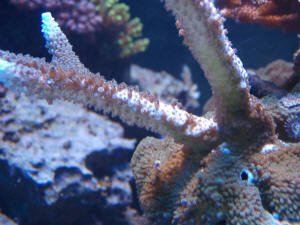 |
Bleaching Acropora Troubles -- 06/10/09
Hello Crew,
<<Greetings Dave>>
I am in need of some trouble shooting assistance.
<<Okay>>
Over the past several weeks I have had several of my Acropora corals
bleaching at the base of the coral.
<<Mmm'¦>>
On most, the tops of the corals still appear to be showing new
growth.
<<Several possibilities... An Acro predator
maybe'¦aggressive stinging corals (sweeper tentacles)
positioned too closely'¦or maybe lighting, etc.>>
I have lost a small blue Acropora and another small frag of Montipora
appears to be almost completely bleached. I have had most of these
Acropora for about a year.
<<Hmm'¦ Perhaps you have inadvertently introduced a
problem organism. Or maybe this is the culmination of a building
problem (e.g. -- allelopathy)>>
I propagated the colony of Acropora that had the most damage a few
weeks ago and they seemed fine for about two weeks. Then the tissue at
the base started to recede again.
<<Not uncommon in my experience'¦ It can be difficult
to save such colonies that have begun to decline>>
The bleaching appears to be spreading to other SPS corals now such as
my green and pink birds nest. Please advise, I don't want to lose
all of my SPS!
<<Mmm'¦ If not a predator (e.g. -- fish, Nudibranch,
crustacean) then perhaps this is a bacterial/microbial complaint. A
prophylactic dip and movement to a quarantine tank may be in
order>>
I have looked for some type of predator and have not seen any red bugs,
flat worms, etc. There is also no brown slime from any of the effected
corals.
<<A predator can be difficult to espy'¦especially if
nocturnal>>
I am puzzled because I have not changed my weekly husbandry of the tank
and the colony that has the worst bleaching, has actually grown onto
the glass.
<<But have you tested your water param.s to exclude a buildup of
nitrogenous compounds as the culprit?>>
I have several large LPS corals including a seven inch maze brain that
have been in my tank for over 7 years with no problems.
<<Unfortunately with this hobby, sooner or later something begins
to tip/upset the 'balance.' Obviously 'something' is
different/has changes in your system>>
I also have two healthy clams, Whisker, Trumpet, Frog Spawn, Acan,
Bubble, Favia, Scolymia, and Dendrophyllia corals that are doing
great
<<Bacterial infestations among corals can often be
Family/Genus/Species specific'¦as are many coral
predators>>
I hand feed most of the LPS corals and have been using Oyster Eggs the
last few days to see if it helps with the SPS bleaching. My 125 gallon
reef has been established for nine years now.
<<Ah, excellent'¦and congrats!>>
I have 6 six-foot VHO bulbs, three Actinic (454 bulbs) and three
AquaSun.
<<This likely isn't the issue'¦and a change
isn't going to save your corals at this point'¦but I
think your 'shallower' species of coral would benefit from
change to a 2 -- 4 ratio respectively here, to increase the amount of
'usable' light>>
The actinic lights come on an hour before and after the main lights.
Temp is between 78
- 80 degrees. Water flow is handled by two main pumps 1800 and 1200
GPH. They are controlled via two SCWDs and four returns. I also have
two other powerheads for dead spots, 800 GPH and 300 GPH. I don't
think water flow is an issue here.
<<Does not seem so, no>>
I have a 45 gallon ADHI refugium with some Chaeto and Halimeda algae
and a Red Mangrove plant. 30 gallon water changes are done weekly. I am
using an Aqua FX RO/DI system for RO water.
<<Have you tested the output lately? Perhaps a
pre-filter/membrane/DI resin change is in order>>
I always premix and pre heat the saltwater days in advance.
<<Very good>>
Salinity level is at 1.025; pH 7.8;
<<Not 'bad''¦but I would increase this above
8.0 for some added 'wiggle room.' Any drop from this point
would be dangerous'¦and could be happening at night when the
lights are off, even with the refugium>>
Nitrates and Nitrites are at 0.
<<Ammonia? And'¦have you validated/used fresh test
kits?>>
Alkalinity is a little on the low side. I have been using baking soda
to bring it up by adding to a high flow area in the sump.
<<Okay>>
I am also using activated carbon via a Magnum filter and use a Berlin
XL skimmer.
<<I would suggest the addition (at least for a while) of some
Poly-Filter to the Magnum>>
I also have automatic fresh water top off for evaporation.
<<Do check that RO/DI filter>>
The only change I can think of is that I replaced my bulbs about three
months ago. I changed the actinic lighting from super actinic to the
454 actinic which has a more blue spectrum rather than purple.
<<I don't think this is an issue'¦ The Actinic
lighting is more for you/you sense of aesthetics anyway. Any good
full-spectrum or Daylight or 10,000K bulb will provide plenty of
short-wave lighting for the corals needs. Utilizing Actinic lighting is
not a problem'¦just be sure to provide enough full-spectrum
light. Hence my suggestion to increase the number of AquaSun bulbs vs.
Actinic bulbs here>>
Should I try to cut back on the lighting?
<<if you are thinking photo-shock could be the
problem'¦I think it is a moot point after three months. Keep
providing 12-14 hours of light per day>>
Other than that, I have been doing my weekly maintenance as always.
<<If an imbalance of the system is not the issue, then you have
likely 'introduced' a pathogen or predator>>
Water change, clean pre filters, change carbon and trim up the Chaeto
algae in the refugium when needed. Please let me know if there is
something I am missing or should try. Your time is always
appreciated.
<<You sound like you have a handle on the maintenance, and are
very familiar with your system (should be after nine years, eh).
I'm afraid, I don't have a silver-bullet for you here. These
issues do just turn up sometimes. A small change/imbalance may have
tipped the scale in a pathogens' favor'¦and they are
usually swift and severe with often little to be done other than watch
and wait. If the affected corals are small enough and/or not encrusted
on large rocks you might be able to save some with a proprietary coral
dip (Tropic Marin has a pretty good one) or maybe just an iodine
dip...along with a move to a clean quarantine system>>
Thanks,
Dave
<<Happy to share'¦ EricR>
Re: Bleaching Acropora Troubles (More than Acro woes now) --
07/27/09
Hello Again Crew,
<<Hi Dave'¦Eric here again>>
It appears that the dying coral issue is a pathogen.
<<And how have you determined this?>>
The issue has now affected just about every coral in my tank.
<<Mmm>>
Just about all of my Zoanthids are closed up and shrinking off the live
rock, including some species that were spreading across the rock at a
very fast rate. My Lobophyllia has receded along with my Scolymia. The
two types of branching Hammer coral are also closed up. Every coral in
the tank looks as if it has lost significant color and the tissue is
flat instead of raised and meaty. Before the corals die, they all seem
to start off with a thin brown diatom looking film on a small part of
the coral and then spreads till it eventually kills the corals. The
fish seem to be unaffected and healthy. I have tried surfing the web
for info on tank wipeout, but they all seem to reference the fish all
dying and not the corals.
<<I suppose it possible that a very high concentration of some
type of bacterium could be the problem. Though I'm not sure I'm
convinced that this is a pathogen'¦affecting ALL your
different coral species but not your fishes. The 'film' you
mention may also simply be an opportunistic organism/alga that is
feeding/replacing necrotic tissue caused by some Allelopathic/water
quality issue(s)>>
In my 12 years of reef keeping, I have never seen anything like
this.
<<Indeed'¦ Most diseases complaints are specific to a
genus/species'¦in my experience>>
I have corals in the tank that I have had for over 7 years. I'm at
a loss here.
<<Perhaps that maturity/growth among a mix of noxious species is
what is at play here>>
I have checked every water parameter that I can think of; ammonia,
nitrate, nitrite, pH, ALK, phosphate, TDS...none of which are out of
range.
<<There are many aspects of water quality we don't, as
hobbyists, have the ability to test>>
The tank, make up, and fresh water top off are all well within range. I
have been doing 40 gallon water changes weekly and have even done a 70
gallon change last week, none of which help the matter.
<<I wonder if something has changed with your source water that
you are not aware of. A couple decades ago I lived in the UK for a few
years. I experienced a couple of whole-tank wipeouts with my budding
reef system. Come to find out the local council was treating the tap
water every few months with a compound (supposedly non-toxic to humans)
to kill freshwater shrimp living/breeding in the water lines
(yeah'¦taught me to filter my source water). I'm not
saying someone is poisoning your water'¦just pointed out
that you don't/can't always know what is or is not in
it>>
I have replaced all the RO filters except the membrane.
<<I think this too may be warranted/worth a try here. If this is
a bacterium issue, it could well be growing on/introduced via the
membrane>>
The digital TDS meter on the RO system showed zero before and after I
swapped the filters.
<<Remember, such readings are only a general guide>>
I have been cleaning the skimmer daily and swapping out the carbon
weekly with no help either. I have not strayed from my weekly regimen
that I have been doing for 9 years now. Is there anything I can do
here?
<<Short of removing, dipping, and placing the corals in a
new/fresh environment'¦likely very little. You could
consider Iodine dosing (Lugol's Solution) as an attempt to hinder
the pathogen, though used in this manner it may have little to no
effect t be honest'¦and has its own dangers if
mis-applied/abused>>
At this point I can't afford to lose all my corals.
<<I do sympathize>>
The quarantine tank is only ten gallons and will not hold a third of my
corals. If I need to setup a new tank to save them, I will... please
advise.
<<Perhaps you need to weigh the cost of the corals (replacement)
versus the cost of a large enough quarantine system. Do also be
aware'¦ If this is indeed an incidental introduction of a
virulent pathogen, just removing (temporarily) and treating the
livestock may not be enough'¦you may be faced with breaking
down the display, discarding sand and rock, and cleaning/sterilizing
tank and equipment. Drastic measures for sure'¦ And I will
ask Bob if he sees this to add his take here>>
If the issue is a pathogen, where does the pathogen reside?...in the
water, on the rock, on the coral itself, in the sand?
<<Maybe all the above>>
I don't believe that it resides in the water judging by the water
changes I have been doing.
<<What leads you to this conclusion I wonder'¦ You are
not changing out 'all' the water at once (and even if you did,
bacteria would still be present), and if the source of the
contamination (again, if indeed this is the issue) is your source water
or storage vessel'¦well then'¦>>
I also have an outbreak of Asterina star fish that has gotten out of
control.
<<Hmm'¦perhaps a clue here>>
If I have to break the tank down, I would like to get rid of these
hitch hikers at that time. Their numbers are far too great for manual
extraction. I have been pulling them out with tweezers for months. I
have found that could tap water seems to kill them within a few
minutes.
<<As it would most any marine invertebrate>>
If I had to break down the reef, my plan of action would be to relocate
the original tank to another room first. Then set up the new tank in
its place. I would then give all live rock a cold fresh water dip to
hopefully rid the rock of the star fish and any pathogens.
<<If a pathogen is involved'¦this may not be enough to
kill it. It's up to you to decide how much of a gamble you're
willing to take, but in such an instance I would be incline to
'replace' the rock/substrate with new>>
I also realize that I would lose most, if not all beneficial bacteria
as well, but I cannot afford a repeat of the same problem.
<<Then reference my previous statement>>
I would let the rock cycle in the old tank
<<To be reinfected?>>
and put the corals in the new tank after an iodine dip with just a
glass bottom for the time being. My question to you is, can I use all
new makeup water and none of the original tank water?
<<Not without maturing/seeding heavily from another
'healthy' system>>
I don't want to use the old water for fear of contamination.
<<Agreed>>
I wanted to add my existing 45 gallon refugium to the new tank...will
there be enough biological matter from the refugium to avoid the new
tank cycling?
<<If a pathogen is present then this too is contaminated.
Everything must be either thoroughly cleaned, treated and quarantined
(as in the coral dips), or discarded'¦no
exceptions>>
The current tank is a 125 and I was looking at a 210 gallon.
<<A nice upgrade'¦and the 125 would make an excellent
sump or refugium re'¦once all cleaned up>>
Please let me know what the best plan of action would be to setup a new
tank and if you think I should salvage the old tank, or setup a new
one.
<<The old system 'is' salvageable as discussed re
cleaning (with bleach) and replacement of rock and substrate,
macroalgae, etc. (based on the assumption of a pathogenic
complaint)'¦ A 'new' system may seem like the best
way to go, but it will still need to be cycled'¦something
that can be done while the livestock is in quarantine for observation
of the problem's continuance>>
Thanks,
Dave
<<Happy to share'¦ Good luck, and please do keep me
posted of the outcome. EricR>>
R2: Bleaching Acropora Troubles (More than Acro woes now) --
07/28/09
Hi Eric,
<<Hiya Dave>>
Just a few more questions.
<<Sure>>
I most likely will upgrade to a newer tank if going to all the trouble
of breaking it down and cleaning it.
<<I see>>
The word "bleach", when associated with a reef tank scares me
=)
<<A normal reaction'¦ Just be sure to use
"pure' bleach'¦as in without added scents or other
modifiers. Rinse everything with copious amounts of clean water. And
where possible, soak bleached gear in a container of water and add a
dechlorinator like Sodium Thiosulfate, then rinse again
afterwards>>
You mentioned to discard the sand and rock...can the rock be
bleached/disinfected and reused?
<<As a last ditch effort, perhaps'¦but better to just
let it dry 'completely' if you are determined to reuse
it>>
...or even left out in the sun?
<<Better>>
I have about 200 pounds of live rock and some really nice pieces that I
would like to keep if possible.
<<Final decision is up to you>>
Also, will the snails and crabs I have in there be an issue?
<<A good question'¦ I suppose they could be
carriers/transporters of bacteria just like anything else>>
...should I iodine dip them and quarantine as well?
<<A short dip in a mild Iodine solution may work'¦be
sure to use clean saltwater rather than freshwater
here'¦else they likely won't survive the dip for
sure>>
Lastly, if I place the existing corals in a quarantine tank with all
new makeup water, will this have an ill effect on the corals?
<<As in fresh from the make-up barrel? Indeed it can'¦
Fresh-made seawater is very aggressive and still chemically active.
Give it a day (good) or two (better) to mature a bit'¦also,
adding some 'seed water' from a 'good' established
system can give it a bit of a jump-start>>
As far as the water source goes, I have well water and don't think
the parameters would fluctuate like public water.
<<Ah but I beg to differ'¦ Something as seemingly
harmless and beneficial as a heavy rainfall can indeed affect the
quality of your well water depending on the activities/industries
around your area. If you're not doing so already, I urge you to add
deionization as a last stage to the RO filter you use to filter water
for your reef system>>
I had it tested last year for everything they could test for and all
was well.
<<That was then'¦ Do consider the problems you are
experiencing with your reef may stem from your well water if your water
treatment equipment/protocol is not up to snuff>>
The Aqua FX RO system is not even a year old yet, but I will replace
the membrane on the RO system for arguments sake.
<<On most municipally treated water systems a good RO membrane
(if flushed periodically) should indeed last for years. But on a well
system this can be more variable and harder to judge. The TDS meter is
a good 'guide' for this, but only measures the amount of
solids'¦not the composition. There may also be compounds
present that don't register on the meter. If/when in
doubt'¦replace the membrane>>
I'm just trying to figure out the best way to go about the move. If
I setup the new tank with new live rock and sand in the display as well
as the refugium, this will take a few weeks to cycle.
<<Yes>>
Mean while, I would discard or bleach the rock and place the corals in
a quarantine tank with all new makeup water.
<<Yes>>
When the new tank is finished cycling, I would then put the corals back
in as long as they appear healthy. Does this seem to be a feasible plan
to you?
<<It does>>
Thanks again for all your help!
Dave
<<Happy to assist'¦ Good luck mate, EricR>>
|
Cyanobacteria 5/25/09
Dear Bob, Mr. Calfo,
<Hello, Scott V. with you today.>
I have big problem with Cyanobacteria which has spread out on my
Acropora on peaks, I am trying to blow them with turkey baster
everyday, but it seems it will not want to leave. When I am
blowing Acropora's peaks-end also some part of tissue is
damaged and coral is losing Zooxanthellae. I have tried to bath
coral in tropic Marin pro cure but Cyano is retrieving back.
<This will not do it.>
Cyano was caused by my mistake that I have put china MH bulbs
instead good ones. Please help!
<Well, in the end there are other fueling factors behind the
BGA besides the light, see:
http://www.wetwebmedia.com/bluegralgae.htm
There are other factors at play. As for your corals, you will
need to figure out what is causing the BGA to be so competitive.
Until then keep blowing off what you can.>
Re: Cyanobacteria 5/26/09
Ok, thank you so much, I will keep trying.
<Welcome, this battle can be won! This is a mild case, you
have caught it early. Scott V.>
|
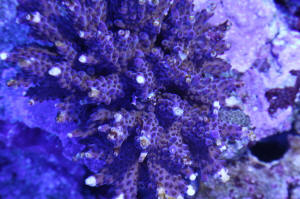 |
|
Pistol Shrimp Hitchhiker: Coral Commensal --
Coralliocaris spp. 5/24/09
Hi Guys, Janet here.
<Hi Janet, Lynn here today>
I bought a colony of Acropora last week and have found 2
hitchhikers in it.
<Neat!>
I know that Acropora generally will come with an Acro crab, but
these little guys are shrimps.
<They sure are. They're small coral commensals, in the
genus Coralliocaris (only around 8-9 species recognized at this
time). Unfortunately, I was unable to find photos of each species
for comparison, but I did find one that looks similar enough to
be a definite possibility. This species, Coralliocaris graminea,
varies in color, but has the same thin, longitudinal lines on the
body, as well as orange-ish tipped legs and claws. Please see the
following links for comparison/more info:
http://tolweb.org/onlinecontributors/app?page=ViewImageData&service=external&sp=26879
http://www.vanaqua.org/aquanews/field/images/yaqara.htm
http://www.seadb.univpm.it/en_Green-Acropora-commensal-shrimp-Coralliocaris-graminea_587.htm
Also, if you happen to have Helmut Debelius' book, Crustacea
Guide Of The World (2nd edition), see page 189. Reportedly, this
Acropora commensal reaches about 1cm in length and is indigenous
to the Indo-West Pacific region.>
They were inside the Acropora colony, and I managed to
"spook" them out and get them into a container for a
picture and to make sure they were reef safe etc. I am attaching
a picture of one of the two.
<Super, thanks>
The other one has no claws, but is identical other than that. The
2 of them must have had a tussle and one ended up with no claws
out of the deal?
<Perhaps yes, or it could have been due to rough
transit/handling when collected, shipped, etc.>
I currently have them in a 10g emergency tank. Do these guys eat
Acro?
<Not according to what I've read. They're commensals
that likely have little negative impact on the colony.>
It is even a pistol shrimp?
<No. Although these shrimps do use their claws to make
clicking/snapping noises, they're not actually what we
consider pistol shrimps (family Alpheidae). They belong to
another family: Palaemonidae, subfamily Pontoniidae. This group
of shrimps doesn't have the same formidable snapping ability
of the Alpheids. Also of note is that the claws of Coralliocaris
species are matched in size, whereas those of the Alpheids are
markedly different. For more in-depth info on snapping claws,
please see this pdf file:
http://decapoda.nhm.org/pdfs/27238/27238.pdf . It's probably
more than you ever wanted to know, but it's
interesting!>
The Acro colony has had some die off which occurred after getting
it home a few days later.
<Can happen sometimes>
I have another smaller colony of Acropora, but this piece is
fine.
<Excellent>
Because of the die off I started taking a look at the colony to
see if I could determine what may be happening to it. This is
when I noticed these little guys. I actually managed to nab both
of them in my 75 gallon tank without losing them and then moved
them to the 10 gallon tank. As you can see by the picture of the
shrimp in my hand, they are very tiny.
<Yep, that's typical for these guys. The genus as a whole
generally ranges in size from 1-2cm.>
This is a picture of the larger one too. Can you provide any
information as to what they are, and if they are reef safe or
not. Do they prey on Acropora only or any Sps coral?
<I haven't come across anything indicating that
they're parasitic, or harmful to corals at all, so you should
be okay.>
Thanks, Janet
<You're very welcome. Take care, LynnZ>
|

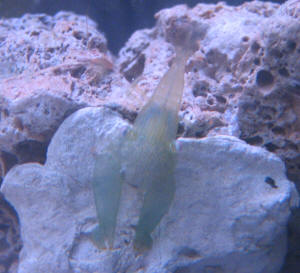 |
|
Re: Pistol Shrimp Hitchhiker: Coral
Commensal -- Coralliocaris spp. 5/25/09
<Hi Janet>
Well, thanks for the great info on my little shrimps.
<You're very welcome.>
I have left them in the 10 gallon as I don't think they will
keep up with my 75 gallon crew of fish and crustaceans. I have a
maroon clown, with a rose bubble anemone and she is rather a
misery and huge! I love her though and would not part with
her.
<I can sure understand. I used to have a tomato clown with all
the charm of a rabid wolverine but I loved her anyway.>
Also a Yellow Tang, tiny Hippo Tang, 1 Coral Perch and 2 Chromis,
2 blood shrimp, 1 coral banded,
<Watch out for this guy. They've been known to kill other
shrimps, hermits and the like.>
..and 1 cleaner shrimp as well as the regular snails, hermits,
serpent stars (also finding baby serpent stars by the dozen, and
also moving them too), and last, 2 sand sifting stars.
<These are neat creatures, but don't do well in most
systems. Unfortunately, they wipe out the sandbed fauna then
starve.>
I also have a Yellow Watchman Goby, and he is paired with a tiger
pistol shrimp.
<Love this combination>
That's another reason why I questioned if these 2 were in
fact pistol shrimps. I did notice that the little guys' claws
were the same size each, but had what looks like the little
snapper.
<Yep, the claws look just like a pistol shrimp's.>
I don't think that whoever shipped this colony of Acropora
would have known they were in there do you think?
<I seriously doubt it. Those shrimps are small, cryptically
colored, and know how to hide within the coral's
branches.>
Sadly there has been more die off and I don't see the
Acropora crab in there anymore.
<Oh? I didn't realize you had a crab hitchhiker as well -
neat.>
Do the Acropora crabs leave the colony if it's not doing
well, or do they die?
<I imagine they stick with the coral until it's pretty
well dead, then move on to another.>
This particular piece was large and nice. It may have been in
rough shape when I bought it, hence the "sale"
price.
<Yep, that's usually a clue that's something's not
quite right.>
I may be able to salvage some by fragging it. Does this make
sense
<Yes, that is if you can't return it for a refund/credit.
Be sure to look over the "Coral Pests and Disease" page
(link below) so you can get a better idea of what's going on
with the coral. If it's rapidly turning white/losing tissue,
it could be RTN (rapid tissue necrosis) or 'white band
disease'. If that's the case, you'll want to remove
the coral and frag it immediately. In the case of pests, follow
the instructions given for each:
http://www.wetwebmedia.com/corldisart.html
More info on Acropora selection, issues, here:
http://www.wetwebmedia.com/acropt3.htm
Good site with a key for diagnosing coral disease:
http://ourworld.compuserve.com/homepages/mccarty_and_peters/coral/Stonyq0.htm
>
..and how should I frag it?
<If it's RTN/WBD, break off healthy pieces well away from
any white areas.>
I have a 30 gallon tall seahorse tank too, but there is also a
blue pistol shrimp in with them. What is your suggestion about
where I could keep these guys?
<Optimally, I'd recommend keeping them with an Acropora
colony. I wasn't able to find any information regarding the
exact diet of these shrimps. They may be like some commensal
crabs in that they feed, at least partially, on the mucus
produced by the coral. I honestly just don't know.>
What about feeding?
<I would try offering a variety of foods and see what they
like, including small meaty bits of marine origin (Mysis shrimp,
silverside, etc), along with some good quality sinking pellets or
even flake food.>
I can just leave them in the 10 gallon as there is nothing
detrimental to them in there. If they are fine in the tank I
don't want to part with them. Did I end up with a rare
find!!???
<Well, it's not something you see every day, but I have
run across other reports of hobbyists finding these shrimps
within their corals. I do believe however, that this is the first
time we've ID'd them here at WWM!>
If the Acropora doesn't make it should I give the skeleton to
them for cover?
<Sure, as long as there's no lingering disease or pests
that might be introduced to any other resident corals.>
It would be a shame to have the entire colony die, I hope to
salvage what I can.
<I sure hope you can too.>
You see when I got it home from the store, I obviously dripped it
and then added it to the large tank. Sometimes I take a turkey
baster and clean the rock of detritus and such. When I did this
around that colony, a lot of the "flesh" pretty much
just blew away exposing the white skeleton.
<Ouch, not good>
I'd only had it a few days. I have a T5 HO lighting system.
Are these sufficient for this type of coral,
<Given enough bulbs and good placement, sure.>
..because I don't want to buy something that won't
survive in my tank, until I can change the lighting system if
required.
<Good thinking. For more information on SPS system
requirements, please see this link:
http://www.wetwebmedia.com/acropt3.htm >
This is a great site! And thank you so much for the extremely
quick response.
Thanks LynnZ
<You're very welcome. It's always nice to chat with
fellow hobbyists about such neat little creatures! Take care,
LynnZ>
|
|
|

